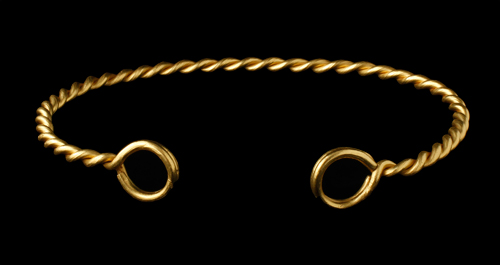
Auction: 1011 - Ancient, English & Foreign Coins, Commemorative Medals & Numismatic Books
Lot: 72
British Iron Age, c.100-50 BC, Gold Torc, 281g, AV 81-85%, AR 14-16%, diameter 195 mm., terminal diameter 28 mm., neck ring twist diameter 7 mm., plain double loop terminals terminating two twisted gold rods each 4 mm. diameter forming a neck ring (Stead 1992, cf. Snettisham L- example in silver; Clarke, 1954, Snettisham hoards B and C, cf. nos, 31-33- in bronze) striations on rods from drawing out of metal in manufacture clearly visible, cleaned, bright gold, extremely fine and a rarely offered example of high status Celtic metalwork Estimate £ 25,000-35,000 provenance East Anglia, probably from near Diss, Norfolk, c.1942 Recorded with the British Museum under the 1996 Treasure Act, 2010, ref. 2010 T194 The ´Diss´ Torc is said to have been found c.1942. The precise location of its discovery is uncertain but it is thought to have been in the Diss area of Norfolk. When found it was not recognised as an Iron Age torc. It was not until 2010 that it came to light again and was recognised as a torc. It was then submitted to the British Museum who confirmed it to be an Iron Age torc and, as a gold object over 300 years old, it qualified as treasure under the 1996 Treasure Act. Following review it was decided that it did not qualify as Treasure Trove and the torc was released back to the owner. East Anglia has produced a large number of Iron Age torcs in gold, silver and bronze. Of these around 25 gold or electrum torcs have been found in Norfolk. By far the most famous series of finds are those from Hen Hill near Snettisham in North Norfolk. In total eleven hoards with over 150 complete or broken torcs were found here between 1948 and 1990, initially as a result of deep ploughing but later through systematic excavation of the site. Finds of the scale of Snettisham are exceptional and single finds or small hoards are more the norm. Other finds in East Anglia include examples from Bawsey, North Creake and Sedgeford in Norfolk, and a group of six found on the outskirts of Ipswich in Suffolk. That another example with an East Anglian provenance should appear is therefore not unsurprising. Stylistically the ´Diss´ Torc is very similar to an example in silver that was in the upper deposit of the Snettisham (1990) hoard L. It is also similar to examples in bronze found in Snettisham hoard B and C and published as items 31-33 in 1954. The style of torcs vary from the elaborate to the simple. By far the best known are the more elaborate torcs, such as examples from Snettisham (especially the so called Great Torc now in the British Museum) and Ipswich, with La Tene style designs on the terminals which are also often hollow cast in structure or with the neck ring of a multiple rod construction. The ´Diss´ torc is much simpler with plain loop terminals. Within the Snettisham hoard 124 examples of this form were recorded. The ´Diss´ torc at 281g is lighter than others such as those from Snettisham and Ipswich. This is in part due to it having a lighter construction and lacking elaborate terminals. Gold content is comparable to the Ipswich examples which range typically at between 80% and 90% gold with the remainder silver. It is now accepted that finds of torcs are most likley votive offerings. Classical writers refer to Celts wearing torcs. Polybius notes Celts going into battle at Telamon wearing little more than a torc and Diodorus Siculus noted that both men and women wore torcs. In Britain however the only reference is by Dio Cassius who talks of Boudicca wearing one. Depictions on coins of heads wearing torcs exist (see lot 75 in this sale) and a torc is notably visible around the neck of the famous classical statue, The Dying Gaul. It is thought that a torc, as a valuable personal item and a store of personal wealth, was regarded as a suitable donation to the gods. Evidence that this practice existed comes from Diodorus Siculus who refers to Gauls placing large amounts of gold in open places as presentations to the gods. The nature of the Snettisham and other finds in Britain supports this, with find locations often a hill top or some similar vantage point, rather than associated with structures or burials. Dating for East Anglian Iron Age torcs tends to associate them with the period 100-50 BC. This is largely on the basis of the Snettisham finds including a number of imported gold (Ambiani) and tin coins which are generally dated to c.75-50 BC. It has been suggested that the source of the gold for many torcs may even have been melted imported coins but this cannot be proven. It is likely though that as the use of coinage spread in Britain after 50 BC, coins took over the role of portable wealth previously taken on by torcs. Almost all examples of East Anglian gold torcs are in institutional collections. This is thought to be the first time an example has been offered at auction. References. Fitzpatrick, A. 1992. The Snettisham, Norfolk, hoards of Iron Age Torques; sacred or profane? Antiquity 66, 395-398 Stead, I. 1991. The Snettisham Treasure: exacavations in 1990. Antiquity 65, 447-465 Clarke, RR, 1952. Notes of recent Archaeological discoveries in Norfolk, 1943-1948, Norfolk Archaeology 30, 156-159 Clarke, RR, 1954. The Early Iron Age treasure from Snettisham, Norfolk, in Proc. of the Prehistoric Society, 20, 27-86 Burns, JE, The Ipswich Torcs, Proc. of the Prehistoric Society, 37, 219- 234. Acknowledgements. Spink would like to thank Dr. Jody Joy of the British Museum for his assistence in identifcation and metallurgical analyis of the torc.
Sold for
£44,000




